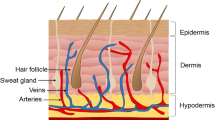Abstract
A review of biologic wound coverings currently in use is presented. These include homografts, xenografts, embryonic membranes, and tissue derivatives. The indications, advantages, and disadvantages of such materials are discussed. Finally, future research directions are suggested.
Résumé
Une revue des techniques de couverture biologique des brûlures est présentée. Celles-ci comprennent les homogreffes, les xénogreffes, l'utilisation de membranes embryonnaires et de dérivés tissulaires. Les indications, les avantages et les inconvénients des différents tissus sont discutés. Quelques espoirs pour l'avenir sont présentés.
Resumen
El tratamiento básico del paciente quemado se fundamenta en el mantenimiento de la homeostasis corporal, el balance de nitrógeno, la competencia inmunológica y la exclusión microbiana, hasta que el cirujano haya removido el tejido no viable y pueda cerrar la herida de la quemadura. Entre más pronto se logre la cicatrización de la herida mayor es la probabilidad de recuperación exitosa del paciente. Existe una variedad de materiales para el cubrimiento de la herida, los cuales se subdividen en coberturas biológicas y coberturas sintéticas. Se presenta una revisión de los materiales biológicos actualmente en boga para la cobertura de la herida por quemadura. Estos incluyen homoinjertos, xenoinjertos, membranas embriónicas y derivados tisulares. Se discuten sus ventajas y desventajas y, finalmente, se mencionan algunos campos de investigación para el futuro.
Similar content being viewed by others
References
Thornton, J.W., Tavis, M.J., Harney, J.H., Pirkle, H., Bartlett, R.H.: Graft adherence to wound surfaces: Collagen fibrin interactions. Burns3:23, 1977
Morykwas, M., Thornton, J.W., Bartlett, R.H.: Zeta potential of synthetic and biological skin substitutes: Effects on initial adherence. Plast. Reconstr. Surg.79:732, 1987
Demarchez, M., Hartmann, D.J., Prunieras, M.: An immunological study of the vascularization process in human skin transplanted onto nude mouse. Transplantation43:896, 1987
Lamke, L.-O.: The influence of different “skin grafts” on the evaporative water loss from burns. Scand. J. Plast. Reconstr. Surg.5:82, 1971
Lamke, L.-O., Nilsson, G.E., Reithnar, H.L.: The evaporative water loss from burns and the water-vapour permeability of grafts and artificial membranes used in the treatment of burns. Burns3:159, 1977
Reverdin, J.L.: Sur la greffe epidermique. C. R. Acad. Sci. (Paris)73:1280, 1871
Reverdin, J.L.: De la greffe epidermique. Arch. Gen. Med. (Suppl 6)19:276, 555, 703, 1872
Menzel, A.: Kleine Beitrage zur Hauttransplantation. Wien. Med. Wochenschr.22:904, 1872
Girdner, J.H.: Skingrafting with grafts taken from the dead subject. Med. Rec.20:119, 1881
Schaper, H.D.: Uebertragung der Pocken durch Implantation wahrend des Prodromalstadiums. Dtsch. Militairarzl. Z.1:53, 1872
Czerny, V.: Ueber dir Entstehung der Tuberculose nach Hauttransplantation. Verh. Dtsch. Ges. Chir.15:22, 1886
Lehmann, W., Tammann, H.: Transplantation und Vitalspeicherung. Bruns. Beitr. Klin. Chir.135:259, 1925
Tammann, H., Patrikalakis, M.: Weitere Versuche uber homoioplastische Hauttransplantationen bei Vitalspeicherung. Bruns. Beitr. Klin. Chir.139:550, 1927
Leicht, P., Muchardt, O., Jensen, M., Alsbjorn, B.F.: Allograft vs. exposure in the treatment of scalds: A prospective randomized controlled clinical study. Burns15:1, 1989
Burke, J.F., Quinby, W.C., Bondoc, C.C., Cosimi, A.B., Russell, P.S., Szyfelbein, S.K.: Immunosuppression and temporary skin transplantation in the treatment of massive third degree burns. Ann. Surg.182:183, 1975
Alexander, J.W., MacMillan, B.G., Law, E., Wesley Alexander, Y., MacMillan, B.G., Law, E., Kittur, D.S.: Treatment of severe burns with widely meshed skin autograft and meshed skin allograft overlay, J. Trauma21:433, 1981
Alsbjorn, B.F.: Langerhans cell depleted allograft skin on excised burns and crural ulcers. Lancet1:1106, 1983
Alsbjorn, B.F.: In search of an ideal skin substitute. Scand. J. Plast. Reconstr. Surg.18:127, 1984
Alsbjorn, B.F.: A depression technique of the epidermal Langerhans cell in cadaver split skin. Scand. J. Plast. Reconstr. Surg.18:61, 1984
Alsbjorn, B.F., Loumann Nielsen, S., Jensen, M.: In vitro suppression of the epidermal Langerhans cell in necro split skin. Scand. J. Plast. Reconstr. Surg.21:273, 1987
Alsbjorn, B.F., Sorensen, B.: Grafting of burns with epidermal Langerhans cell depressed split skin. Burns11:259, 1985
Alsbjorn, B.F., Sorensen, B.: Grafting of burns with widely meshed autograft split skin and Langerhans cell-depressed allograft split skin overlay. Ann. Plast. Surg.17:480, 1986
Katz, S.I., Kunihko, T., Sachs, D.H.: Epidermal Langerhans cells are derived from cells originating in bone marrow. Nature282:324,1979
Stingl, G., Tamaki, K., Katz, S.I.: Origin and function of epidermal Langerhans cells. Immunol. Rev.53:149, 1980
Braathen, L.R., Thorsby, E.: Studies on human epidermal Langerhans cells: I. Allo-activating and antigen-presenting capacity. Scand. J. Immunol.11:401, 1980
Hefton, J.M., Madden, M.R., Finkelstein, J.L., Shires, G.T.: Grafting of burn patients with allografts of cultured epidermal cells. Lancet1:428, 1983
Alsbjorn, B.F.: Clinical results of grafting with epidermal Langerhans cell depressed allograft overlay. Scand. J. Plast. Reconstr. Surg. (in print)
Petersen, O.: Ueber Transplantation von Frohschhaut auf granulirende Wunden des Menchen. St. Petersb. Med. Wochenschr.2:326, 1885
Sabella, N.: Use of the fetal membranes in skin grafting. Med. Rec.83:478, 1913
Sawhney, C.P.: Amniotic membrane as a biological dressing in the management of burns. Burns15:339, 1989
Author information
Authors and Affiliations
Rights and permissions
About this article
Cite this article
Alsbjörn, B.F. Biologic wound coverings in burn treatment. World J. Surg. 16, 43–46 (1992). https://doi.org/10.1007/BF02067113
Issue Date:
DOI: https://doi.org/10.1007/BF02067113




